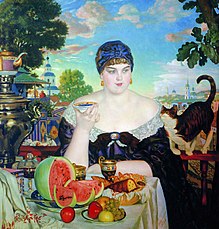This article needs additional citations for verification. (May 2024) |


Tea culture is how tea is made and consumed, how people interact with tea, and the aesthetics surrounding tea drinking.
Tea plays an important role in some countries. It is commonly consumed at social events, and many cultures have created intricate formal ceremonies for these events. East Asian tea ceremonies, with their roots in the Chinese tea culture, differ slightly among East Asian countries, such as the Japanese or Korean variants. Tea may differ widely in preparation, such as in Tibet, where the beverage is commonly brewed with salt and butter. Tea may be drunk in small private gatherings (tea parties) or in public (tea houses designed for social interaction).
Afternoon tea is a British custom with widespread appeal. The British Empire spread an interpretation of tea to its dominions and colonies, including modern-day regions of Hong Kong, India, and Pakistan, which had pre-existing tea customs, as well as regions such as East Africa (modern-day Kenya, Tanzania, and Uganda), the Pacific (Australia and New Zealand), and Canada, which did not have tea customs, or countries that received high British immigration, such as Chile. The tea room or teahouse is found in the US, Ireland, and many Commonwealth cities.
Different regions favor different varieties of tea—white, yellow, green, oolong, black, or post-fermented (dark)—and use different flavorings, such as herbs, milk, or sugar. The temperature and strength of the tea likewise vary widely.